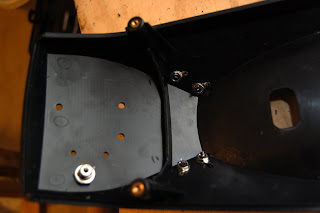Got it all set up this afternoon and roughly oriented to celestial north (we had previously marked paving stones in the yard that we use for the tripod legs with the directions for celestial navigation) and waiting til dusk. About then I realized I hadnt balanced the scope on the wedge .... um yeah - that went fantastically (sarcastic of course) ... when I balanced on alt-az once I had the piggyback scope it didnt take too long to get a dynamic balance, not the case on the wedge so #1 thing to add to the "do in the daytime" list. I got it close and about that time the stars were becoming visible.
I started to align the wedge and scope with my polar scope (the arm I made isnt SUPER sturdy (just sheet metal) - so this was just to get me roughly close) ... got close there and got closer using eyepieces. Then I ran through the Celestron Equatorial Alignment sequence (as that is what my manual says to do after you have a close polar alignment). Did that no problems. Then my manual says to do a "wedge align" - only problem is there is no wedge align in the menu .... had to come inside to read that my upgraded firmware replaced that with something else. Check - back out to the scope .....
At this point I wanted to see how well I was doing so I put in my Ha filter and slewed to the Horsehead Nebula -- spot on center so yay the alignment mustve been pretty close. I set it for a 60sec image just to gauge how close to a polar alignment I was .... only slight star trails so semi-encouraging. At this point I decided that perhaps I didnt run through the new sequence quite right so I powered down and ran through it all again, this time I added in the "Polar Align" after the "Eq Align" as the new firmware recommends. Slightly off for the polar align sequence so readjusted the mount in that step and then went back to HH to try again ... not center anymore - in fact it was JUST barely in the screen - AW SNAP - mustve not had as great alignment this second go-around ... tried another 60sec image - slightly worse than the first run-through ... GRRR!!! Reassessed and realized I hadnt done the "Polar Align" right. My feet were frozen by this point (note to self - dont wear sandals out on tomorrow's try) so I came in to watch tv and warm up with two giant Great Pyrenees as feet and lap warmers.
I just went out and put the scope to bed for the night with the following lessons learned:
1) balance the scope in the daytime ... (and sand that metal bur off the bottom of the counterweight set - I sliced my hand open twice on it tonight)
2) work on the cord situation .... not as much as a problem on alt-az but this extra angle makes the cords quite a mess - fix that in the daytime too
3) reposition polar scope arm ... where I have it gets me close but not close enough ... perhaps move it to the center and just use it before I put the scope on the wedge
4) Dont let the scope auto-pick the alignment stars, at one point i was half-upside down balancing off the fence to get my head where I could see through the finder and eyepiece .... I am not acrobatic so was not very fun
5) be super accurate when aligning so its less error that needs to be corrected in the "polar align" step.
I didnt expect to get it down pat the first try and be off and imaging 5-10 min subs without an autoguider just on my superb polar alignment skills an hour after attempting it, but got at about 60s subs without really knowing what I was doing so all in all a fairly successful night. I am planning another attempt tomorrow, and if it goes well might get the PEC training for the scope in as well and attempt some autoguiding (my guide camera should be in tomorrow ... though that would mean balancing my piggyback as well - hmmmm come to think of it perhaps that should wait a few more days until this polar alignment thing is slightly easier for me).
Ok I am done rambling for tonight!










